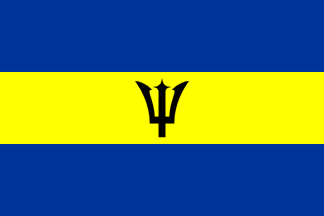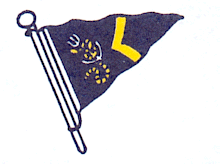 (2:3)
(2:3)
image by Željko Heimer, 24 Febuary 2001

Last modified: 2010-02-06 by dov gutterman
Keywords: barbados | caribbean | trident | barb | west indies | fig tree | dolphin | pelican | pelican island | sugarcane | st. andrew | west indian federation |
Links: FOTW homepage |
search |
disclaimer and copyright |
write us |
mirrors
 (2:3)
(2:3)
image by Željko Heimer, 24 Febuary 2001
Official Name: Barbados
Capital: Bridgetown
Location: Caribbean
Government Type: Constitutional Monarchy (Queen
Elizabeth II)
Flag adopted: 30
November 1966
Designer: Grantley Prescod
Coat of arms adopted: 21 December 1966
ISO Code: BB
See also:
National flag. CSW/C-- 2:3 - Different sources differ in the
representation of the shape of the trident - possibly it is not
entirely defined or it may have changed over the years. All
sources seem to agree that the blue shade is lighter then the
standard blue used in the UJ (and in the Governor
General of Barbados flag) and yellow is in all representation
dark, almost orange. [smi80]
designate the flag as CSW/CSW, but since BB has no navy and since
(as it seems) the white ensign was introduced in the mean time (Naval and Coast Guard Ensign), the usage
designation seems to be all right as shown in Album 2000.
Željko Heimer, 24 Febuary 2001
Barbados flag colour shades from Album 2000 [pay00] are:
Pantone --- CMYK
B 280c --- 100-70-0-20
Y 123c --- 0-30-90-0
Santiago Dotor, 26 Febuary 2001
When I was in Barbados I checked the flag. The blue was
uniformly a medium-dark; darker than that usually seen in the
French flag, for example, but lighter than that of the US. I'd
simply call it B+ in quick descriptions. Likewise the yellow is
Y+, rather rich in tone.
Al Kirsch, 26 Febuary 2001
According to Politikens Flagbook [rya00a] the flag was the winning
proposal in a nation-wide contest, and was designed by an
Grantley Prescod, teacher of arts.
Peter Hans van den Muijzenberg, 7 October 2001
In English heraldry a "barbe" is a trident with
barbed points, hence the world's only canting national flag (as
far as I know), Barbados.
James Dignan, 9 November 2004
The word "Barbados" comes from Portuguese (or maybe
Spanish) meaning "beard [ones]", refering to local
mangove-like sea-side trees. So, as we know, the trident is more
recent than the name, and its etymology is convoluted (though not
false).
Antonio Martins, 9 November 2004
A few extra facts were found on this official page.
British Standard colour code numbers: "Ultramarine: BCC148,
Gold: BS0/002".
The designer of above flag, Grantley W. Prescod, died in 2003.
Quote from above site concerning the flag's selection process and
some biographical information:
"His design was chosen from 1,029 entries in an open
competition organised by the Government of Barbados. Mr. Prescod
was awarded a Gold Medal, an inscribed scroll from the government
and $500 which was donated by the Advocate Company Limited. The
judges of the competition were Mr. Bruce St. John, Chairman,
Major Leonard Banfield, Mr. Maurice Cave, Mr. Neville Connell,
Mrs. Enid Lynch and Mrs. B. Ward.
Mr. Prescod attended St. Barnabas Boys School. He taught before
undertaking a one year course at the West of England College of
Art for Specialist Teachers of Art in 1962-63. He also attained a
certificate in Education from Bristol University. Between 1967-72
he studied f[or] the Master of Education degree majoring in Art
Education at Temple University, Philadelphia, U.S.A.
Mr. Prescod has taught at the Parkinson Secondary School. He
served as an Education Officer from September 1977 until he
retired in February 1987.
Mr. Prescod died on November 12, 2003 at the age of 77."
Obituary, photo, and more design details (quote following) at
<www.islandmix.com>.
"Prescod did not only win the competition to design the
island's symbol of Independence, he actually made the first
Barbados flag, after having been sent to Cave Shepherd by then
Premier Errol Barrow to choose the lightest of fabrics in the
identified colours.
In an interview last year, Prescod recalled that he chose
"yards and yards and made about seven large flags". A
neighbour of his sewed the pieces together."
Jan Mertens, 3 November 2007
The blue on the left is for the sky, the gold for the sand,
the right blue for the sea. The trident in the middle represents
the break with England at independence - the trident is broken,
thus only the top is showing. The name of Barbados comes from the
Portuguese name Os Barbados meaning bearded one, because
of the bearded fig tree that used to cover the island. The three
points of the trident represent the three principles of democracy
- government of, for and by the people.
James Dignan, 22 November 1995, "Amanda" from
Barbados, 20 May 1998
According to Politikens Flagbook [rya00a] (my translation):
"Prescod explains the stripes as symbol for the blue sea and
the golden sand, that encircle the island. The trident is taken
from the previous flag-charge, which showed Britannia holding a
trident (symbol for her rule
over the seas). Here, the trident is without shaft as a symbol
for the break with the colonial past. Simultaneously it
symbolizes the sea god Neptune and reflects the sea's large
significance for Barbados."
Peter Hans van den Muijzenberg, 7 October 2001
from the official site of the Barbados government :

image by Željko Heimer and António
Martins-Tuválkin, 14 December 2005
When reporting BB stamps with flags, Ron Lahav
mentioned a Barbados flag with horizontal rather than vertical
stripes, which is shown in stamp
SG 677, issued in 1981 for the Carifesta (Caribbean Festival
of Arts), Barbados.
I cannot swear that the thing in the middle of this
blue-yellow-blue horizontal equial triband is a black trident,
but there's something there alright.
António Martins-Tuválkin, 14 December 2005
The Government of Barbados Information Service does proclaim
that it is the Barbados flag at <www.barbados.gov.bb>.
Ned Smith, , 14 December 2005
This is not correct. There is no Horizontal
variant. This layout is used in banners at parades and
to decorate buildings on Independence day. It represents the
national colours but is not a flag. It is never used as a
flag. The image on the stamp must be an art error, or
it was a special event banner on that occasion.
Craig Ashby, 19 June 2006
Barbados is divided to 11 parishes. There are no known flags
of those parishes. The parishes are:
- Saint Andrew
- Christ Church
- Saint Peter
- Saint George
- Saint John
- Saint Lucy
- Saint Michael
- Saint Joseph
- Saint Philip
- Saint James
- Saint Thomas
List based on Administrative
divisions of the World.
Dov Gutterman, 25 October 2004
According to this WMO
page, Barbados uses signals 45a and 41a: 45a, a green flag,
is defined as "The island is out of danger. The green flag
of the day signal has a white diagonal stripe" which really
means that the 45a picture does not apply to Barbados, as it is
incomplete. 41a is the well-known set of two black flags pierced
red,meaning "Hurricane conditions are expected within 24
hours."
Jan Mertens, 1 November 2007
The 100th anniversary of Barbados Cadet Corps was commemorate
with a series of stamps, one
of which show its flag.
Barbados Postal Service web site show it at: <bps.gov.bb>
with a description:
"The Cadet Banner features the Corps’ Crest worn on the
headdress of the Cadet Corps’ members. The Crest, which is
blue and gold, is set on a blue background. Over the years the
Cadet Crest has been in the form of the Star of David. The centre
design of the Crest has been altered each time there has been a
change within the structure of the military in Barbados. For
instance, in the days of the Barbados Regiment, the Crest showed
the Queen with the Trident in hand. The current Crest shows the
hand holding two pieces of sugar cane which is part of the Coat
of Arms of Barbados. This Banner was established within the early
1980’s after the establishment of the Barbados Defence
Force.
Dov Gutterman, 24 September 2008
I feel bound to point out that the lady brandishing the
trident in the erstwhile colonial badge of Barbados was, in fact,
Britannia.
Peter Johnson, 24 September 2008

image from Barbados
Yacht Club web site
From Barbados
Yacht Club web site:
"As deemed appropriate in March 1991, the Management
Committee and Commodore Charles F. Packer commissioned a
contemporary emblem for the Barbados Yacht Club. The previous
insignia featured a Royal Coronet, a chevron and a flying fish,
and was utilized from 1932 to 1967. It was granted to the Yacht
Club during the empirical reign of King George V. Therefore a new
design was sought to convey the heritage of the past within the
society of a post independence Barbados.
The Board of Management retained the expertise of Heraldic Artist
Ann Rudder, who prepared a portfolio of sample logos for the
Yacht Club with relevant marks of identity for the Flag, Burgee,
Letterhead and all Properties thereof. The chosen logos were
submitted to the Cabinet Office of the Government of Barbados.
Permission of use was granted on October 17, 1991; for the
following emblem as blazoned:
Sable, issuant of a fess wavy Aqua and Azure at honour point a
chevron Or, conjoined in chief each to the dexter and sinister
with three piles nebuly Argent; surmounted in pale by a trident
anchor stocked of the first, fimbrated and fluked of the last,
cabled and bearing an annulet of the fourth, upon which the
initials B Y C are displayed.
The Coat of Arms of the Barbados Yacht Club depicts a Golden
Chevron arising from a wavy blue sea. This symbol has been
retained from the original grant. The word is derived from French
chevron, to describe a gable rafter for the roof of a
building or the central beam for the keel of a ship. Symbolically
this would convey protection or shelter on land or sea. An early
grant for the Carpenters’ Guild dated 1333, displayed the
chevron with three drafting compasses. Other worshipful companies
such as the Joiners and the Masons added the ‘L’ square
to their badges. Such fraternities were concerned “with the
mutual assistance of members of their brotherhoods in poverty,
sickness and death”. The duty of building individual moral
character within the preservation of these essentially all male
craft guilds was the foundation of most Masonic lodges, which
retain the compass and ‘L’ square emblem into modern
times.
The Anchor originated from pre Roman times. It became known to
Christian seafarers whose scriptures told of, “Which hope we
have as an anchor of the soul, both sure and steadfast”. Hebrew
6:19. Subsequently the anchor became symbol of Bishop
Nicholas, Patron Saint of sailors, travelers and children.
Mythically Poseidon [Neptune] ruler of oceans possessed the
Trident-Staff upheld by ‘Britannia’ who ruled the seas.
Although Barbados ‘broke’ from empire on November 30,
1966, the trident head was retained to indicate a civil
independence, and is foremost of all national emblems. Therefore
the grant to the Barbados Yacht Club is significant."
Dov Gutterman, 11 October 2008